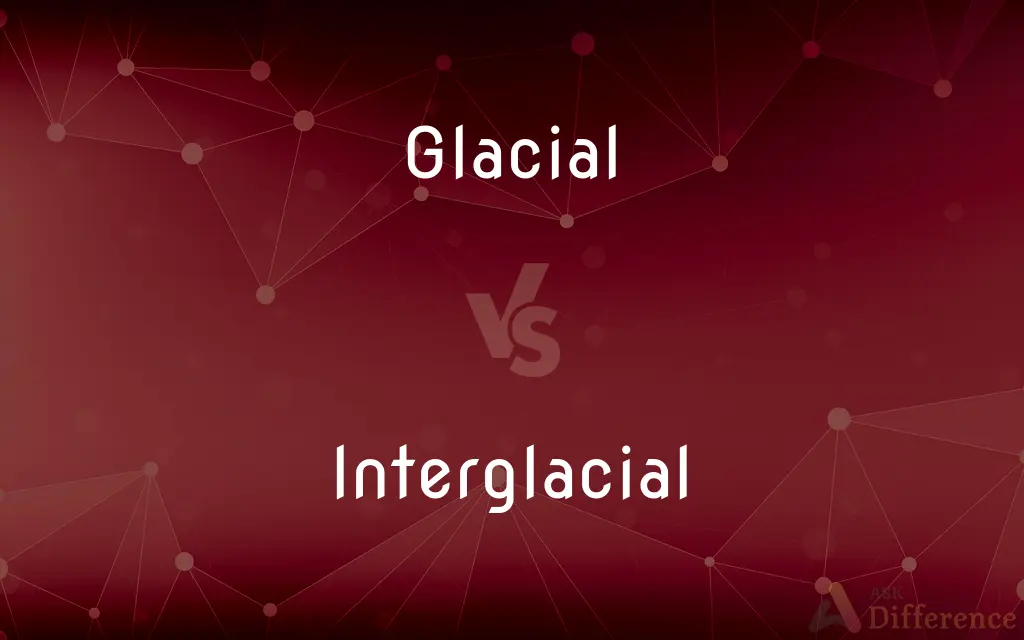Glacial vs. Interglacial — What's the Difference?
By Tayyaba Rehman — Published on November 7, 2023
Glacial periods showcase extensive ice sheets and cooler global temperatures, while Interglacial periods exhibit warmer climates and receding glacial ice, each significantly influencing ecosystems, sea levels, and weather patterns on a global scale.

Difference Between Glacial and Interglacial
Table of Contents
ADVERTISEMENT
Key Differences
Glacial and Interglacial periods punctuate the Earth's history, significantly influencing its climate and geography. Glacial epochs embody times of extensive ice sheet presence, particularly within polar regions and high altitudes. Meanwhile, Interglacial periods, in contrast, exemplify eras wherein these extensive ice formations retreat due to warmer global temperatures, bringing forth milder climate phases.
Through the lens of global climates and ecosystems, Glacial periods have molded the Earth with impressive ice structures and have driven fauna and flora to adapt to harsher, colder conditions. Interglacial periods, conversely, have permitted a thaw, enabling ecosystems to recover, diversify, and often, migrate, as previously ice-bound regions become accessible and habitable due to the receding ice.
Understanding Glacial epochs necessitates the exploration of expansive ice sheets and colder global temperatures, which can significantly alter sea levels, weather patterns, and global biota. On the flip side, Interglacial intervals introduce warmer climates, a pronounced reduction in global ice coverage, and consequently, often higher sea levels and different weather patterns, altering habitats and influencing evolutionary trajectories.
In geological and climatic studies, Glacial periods serve as bookmarks that guide scientists through Earth’s historical climatic phases, providing clues about past environments, weather patterns, and living organisms. Interglacial periods are equally pertinent, offering insights into climatic shifts, ecosystem changes, and providing critical context to evaluate current and future climate scenarios by examining past warm epochs.
Considering anthropogenic climate change, acknowledging the distinctions and transitions between Glacial and Interglacial periods is paramount. While Glacial periods exhibit massive, often continent-scale ice sheets and significantly colder climates, Interglacial epochs represent periods of relative warmth, reduced ice coverage, and different patterns of precipitation and drought, each contributing uniquely to the paleoclimate record.
ADVERTISEMENT
Comparison Chart
Climate
Generally cold, favoring ice sheet expansion.
Warmer, promoting ice sheet contraction.
Ice Coverage
Extensive, often continent-scale.
Significantly reduced compared to glacial periods.
Sea Levels
Typically lower due to ice sequestration.
Generally higher due to melted ice.
Ecosystems
Adapted to colder conditions.
Tend to be more diversified and widespread.
Temporal Occurrence
Occurs in cyclic intervals throughout history.
Interspersed between glacial periods.
Compare with Definitions
Glacial
Glacial signifies being of, relating to, or resembling glaciers or icy conditions.
The glacial environment of Antarctica dictates a unique, adapted ecosystem.
Interglacial
Interglacial signifies a period of reduced ice cover on Earth’s surface.
Flora and fauna often flourish in the relatively mild conditions of an interglacial.
Glacial
Glacial may describe something that is extremely cold in temperature.
The glacial waters of the Arctic are perilous for unprepared explorers.
Interglacial
Interglacial denotes a period of warmer global temperatures between glacial epochs.
Humanity’s entire recorded history has occurred within an interglacial period.
Glacial
Glacial refers to an extensive period of significantly cooler global temperatures.
During the last glacial period, mammoths roamed across ice-covered plains.
Interglacial
It relates to geological or paleontological features formed during an interglacial period.
Interglacial layers within ice cores reveal vital data about past climates.
Glacial
It relates to, or is denoted by, the presence of large-scale ice formations.
Glacial landscapes can sculpt the Earth, creating various geomorphic features.
Interglacial
It refers to a period where glacial ice significantly recedes or disappears.
Interglacial epochs offer crucial insights into the Earth’s climatic shifts.
Glacial
It indicates a slow, inexorable, or very gradual movement or progress.
The glacial progress of the project frustrated the team.
Interglacial
Interglacial pertains to the phenomena, deposits, or effects of an interglacial epoch.
Interglacial periods have facilitated the migration and adaptation of various species.
Glacial
Of, relating to, or produced by a glacier.
Interglacial
Occurring between glacial epochs.
Glacial
Extremely slow, like the movement of a glacier
Work proceeded at a glacial pace.
Interglacial
A comparatively short period of warmth during an overall period of glaciation.
Glacial
Often Glacial Characterized or dominated by the existence of glaciers. Used of a geologic epoch.
Interglacial
Occurring between glaciations (colloquially known as ice ages).
Glacial
Pleistocene. See Table at geologic time.
Interglacial
The relatively warm period between glacial periods.
Glacial
Extremely cold; icy
A glacial rain.
Glacial
Having the appearance of ice.
Glacial
Lacking warmth and friendliness
A glacial stare.
Glacial
Coldly detached
A glacial composure.
Glacial
Of, or relating to glaciers.
We examined the glacial deposits.
Wang Shijin is a glacier expert and director of the Yulong Snow Mountain Glacial and Environmental Observation Research Station. File:Wang Shijin is a glacier expert.ogg
Glacial
(figuratively) Very slow.
Glacial
Cold and icy.
After the rain and frost, the pavements were glacial.
Glacial
Having the appearance of ice.
On cold days, glacial acetic acid will freeze in the bottle.
Glacial
(figuratively) Cool and unfriendly.
He gave me a glacial stare.
Glacial
A glacial period (colloquially known as an ice age).
Glacial
Pertaining to ice or to its action; consisting of ice; frozen; icy; esp., pertaining to glaciers; as, glacial phenomena.
Glacial
Resembling ice; having the appearance and consistency of ice; - said of certain solid compounds; as, glacial phosphoric or acetic acids.
Glacial
Relating to or derived from a glacier;
Glacial deposit
Glacial
Devoid of warmth and cordiality; expressive of unfriendliness or disdain;
A frigid greeting
Got a frosty reception
A frozen look on their faces
A glacial handshake
Icy stare
Wintry smile
Glacial
Extremely cold;
An arctic climate
A frigid day
Gelid waters of the North Atlantic
Glacial winds
Icy hands
Polar weather
Common Curiosities
How does a Glacial epoch affect global weather patterns?
Glacial epochs generally prompt altered weather patterns, like prolonged cold spells, changes in precipitation zones, and potentially impacting monsoon systems, due to the expansive ice coverage and alterations in global temperature.
How are ecosystems influenced during an Interglacial period?
During an Interglacial period, ecosystems may experience increased diversity, species migrations, and adaptations to warmer climates, as well as changes in available habitats due to altered geography and weather patterns.
What happens during an Interglacial period?
Interglacial periods are warmer epochs during which ice sheets retreat, sea levels rise due to melting ice, and ecosystems undergo changes, often becoming more biodiverse.
What causes transitions between Glacial and Interglacial periods?
Transitions between Glacial and Interglacial periods are primarily driven by Earth’s orbital variations, changes in greenhouse gas concentrations, and various feedback mechanisms within the Earth’s climate system.
How long does a typical Glacial period last?
A typical Glacial period can last for several tens to hundreds of thousands of years, though the duration can be influenced by various factors including greenhouse gas concentrations and volcanic activity.
How does wildlife adapt to Glacial periods?
During Glacial periods, wildlife may adapt through migration, evolutionary changes, or extinction, responding to the colder temperatures, altered habitats, and available resources.
What is the duration of an Interglacial period?
Interglacial periods typically last between 10,000 and 30,000 years, although this can vary based on numerous climatic and environmental factors.
What characterizes a Glacial period?
Glacial periods are characterized by extended ice coverage, colder global temperatures, and changes in ecosystems and sea levels due to water being stored in ice sheets.
How do Glacial and Interglacial periods impact sea levels?
Glacial periods often correspond with lower sea levels due to water being stored in ice sheets, while Interglacial periods generally exhibit higher sea levels due to the melting of ice and the expansion of seawater as it warms.
Are we currently in a Glacial or Interglacial period?
We are currently in an Interglacial period, known as the Holocene, characterized by relatively warm temperatures and reduced ice coverage compared to a glacial epoch.
Why is understanding past Glacial and Interglacial periods important?
Understanding past Glacial and Interglacial periods is vital to comprehend Earth’s climate history, providing insights into natural climatic variations and helping to predict potential future climatic changes.
How do Glacial and Interglacial periods affect ocean circulation?
Glacial and Interglacial periods can affect ocean circulation by altering temperature and salinity gradients within the oceans, impacting global climate patterns and marine ecosystems.
Can human activities influence the transition between Glacial and Interglacial periods?
Yes, human activities, particularly those increasing greenhouse gas concentrations, such as burning fossil fuels, can influence the climate and potentially affect transitions between Glacial and Interglacial periods.
How are Glacial and Interglacial periods identified in the geological record?
Scientists identify Glacial and Interglacial periods in the geological record through various means including studying ice cores, ocean sediments, and rock formations, which reveal past temperatures, ice volumes, and sea levels.
How have Interglacial periods influenced human development?
Interglacial periods, especially the current one, have significantly influenced human development by providing stable, warmer climates that allowed for the development of agriculture, civilizations, and technological advancements.
Share Your Discovery

Previous Comparison
PDT vs. PST
Next Comparison
Red Lentils vs. Green LentilsAuthor Spotlight
Written by
Tayyaba RehmanTayyaba Rehman is a distinguished writer, currently serving as a primary contributor to askdifference.com. As a researcher in semantics and etymology, Tayyaba's passion for the complexity of languages and their distinctions has found a perfect home on the platform. Tayyaba delves into the intricacies of language, distinguishing between commonly confused words and phrases, thereby providing clarity for readers worldwide.













































